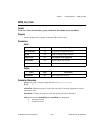
Chapter 2 Function Reference — WFM_Op
NI-DAQ FRM for PC Compatibles 2-436
©
National Instruments Corporation
If you have changed the analog output configuration from the defaults by changing the
jumpers on the device, you must call
AO_Configure to set the software copies of the settings
prior to calling
WFM_Op.
NI-DAQ ignores the group settings made by calling
WFM_Group_Setup when you call
WFM_Op and the settings are not changed after NI-DAQ executes you execute WFM_Op.
Note For the MIO-16/16D, counter 2 must be available in order to use waveform
generation. If an interval scan is in progress (see
SCAN_Start) or a CTR function
is using counter 2, waveform generation cannot proceed.
For the AT-MIO-16F-5, AT-MIO-64F-5, and AT-MIO-16X, you can use counter 1, 2, and 5,
as well as a dedicated external update signal, to generate either interrupt or DMA requests.
If you use counter 1 or 2, a RTSI line must also be available. NI-DAQ uses the first available
counter among counters 5, 2, and 1, in that order.
For Lab and 1200 Series analog output devices, if the rate is smaller than 15.26 and counter
B0 is busy in a data acquisition or counting operation, waveform generation cannot proceed.
On Am9513-based MIO devices, to externally trigger a waveform generation operation, you
can do so by first changing the gating mode of the counter NI-DAQ will use.
WFM_OP will use either the default gating mode (none) or the gating mode you specify through
the
CTR_Config function. You will need to connect your trigger signal to the gate pin on the
I/O connector. Refer to the
CTR_Config function description for details.
On E Series devices, you can externally trigger a waveform generation operation in a variety
of ways. Refer to the
Select_Signal function for more details.
The DSA devices use 32-bit data buffers. If you are using C or Delphi, you will need to
typecast your i32 array to i16 when you call
WFM_Op
. If you are using Visual Basic, you
should use the
nidaqr32.bas
file (instead of
nidaq32.bas
) to relax type checking on
buffer. The DSA devices use the upper 18 bits of each buffer element. The lower 14 bits are
ignored and you should set them to zero. You can move each data point into the upper 18 bits
with a left shift operation by multiplying it by 16,384.


















